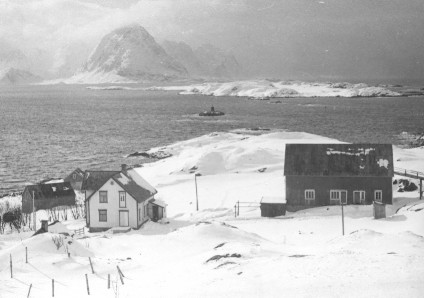 |
Skogsøya is a small montainous island in Vesterålen, with the North Atlantic ocean as its closest neighbour to the west. The name means 'the forrested island', an appropriate name a thousand years ago, when the climate was warmer and pine forrest covered the lowland. Today you'll find only birch woods there. We don't know exactly how long human beings have been living at Skogsøya. The last ice age ended ten thousand years ago, and the hunters arrived perhaps two thousand years after that. We believe now that the great ice cap never covered the outer parts of Vesterålen, but of course there were numerous local glaciers, and they carved out the valleys. On the southwestern corner of this island there's a farm - or rather a group of farms - called Hjellsand. It's a very old name, and people have lived there for thousands of years. I was born there in 1939, and this picture shows our place on a winter Sunday some years ago. In the background you can see the mountain Tinden - 'The Peak' - on Tindsøya. To the right of Tinden there's nothing, except for the ocean. Greenland is somewhere beyond many horizons ... |
|
There are neighbours close by, this picture shows some of them. (Very calm sea when I took this snapshot from our boat on a fine Sunday in July!) The strip of sand to the left has given this place its name. Behind the line of houses the islands mountains are stretching 1200 feet or more upwards. Every autumn we pick berries in the hillsides, and some people go hunting there. You can also see a valley stretching inland, and there are many of them on Skogsøya. Between the row of houses and the hillside is a little lake. With fish, of course, mostly trout. In two larger lakes on the northern part of the island you'll also find salmon. Or perhaps it has gone now. The stock of wild salmon is reduced everywhere due to many causes. The neighbours, yes. They lived in those houses when I took this picture, but today most of them have moved away. So this is a nostalgic trip. Around 1950 the island had five hundred inhabitants, today a population history many thousand years long is coming to an end. Like the history of the wild salmon. |
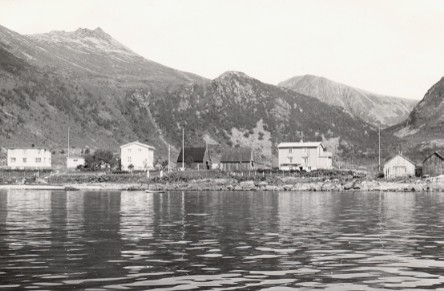 |
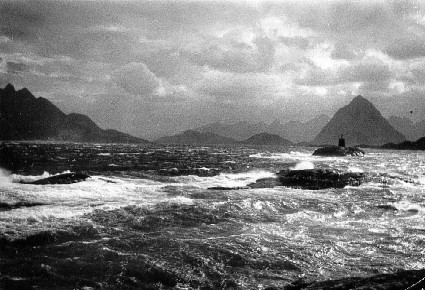 |
As a counterbalance to the summer Sunday silence above I'll show you what the sea may look like when a storm hits the coast. Well, actually this was only a strong breeze, but then you can imagine the sight when storm waves are hammering the rocks. Almost nothing can withstand the blows from the sea, and these waters have taken the lives of many fishermen. The biggest loss of lives on a single day, as far as we know, happened January 25, 1893. 26 fishermen perished in the waters around Skogsøya, and a hundred more in neighbouring parishes. At that time they used open boats with five to seven men on each. In Øksnes parish, where these pictures were taken, more then seven hundred fishermen drowned or froze to death during the two centuries between 1700 and 1900. That's a very heavy loss, if you compare it with the population size: In 1700 Øksnes had three hundred inhabitants, in 1900 three thousand. By the way, there's Tinden again to the right (on Tindsøya), and to the left you can see a part of Dyrøya. (If you wonder what 'øya' means, the translation is 'the island'.) One the other side of Tinden there's a little fishing hamlet with the same name. If you take a look at the page with colors, you'll find a picture from Tinden and another hamlet, Skipnes. |
My father was a fisherman, and where there are fishermen, there also are nets. Here some of them are suspended over a 'hjell', a rack for drying fish. You may think that this word has given Hjellsand the first part of its name, but that's a wrong guess! In the background you can see some of the other farms, and also the sand that you'll find as the last part of the place name. They don't use this old method for drying fish now. The catches are now being landed in large fishing harbours, and their destination is big production lines. You won't see fish-filled 'hjeller' in small hamlets as Hjellsand any longer, therefore many such places are dying today. Small hamlets like Hjellsand were well suited in the sailboat days, which was before 1900. After that decked boats with motors were used as fishing wessels, and they needed bigger and more sheltered harbours. Of course people moved with the boats, and large 'fiskevær' (fishing stations) grew up around the best harbours. A 'fiskehesje' resembles a cathedral and the nets are very ornamental. No wonder that almost all photographers visiting the coast of Northern Norway have taken pictures of them! But soon these sights will disappear, I'm afraid. (By the way, many call this a "hjell", but hjells are flat-topped.) |
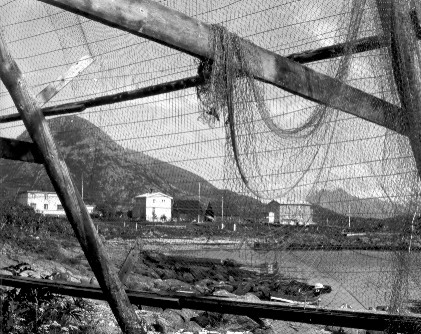 |
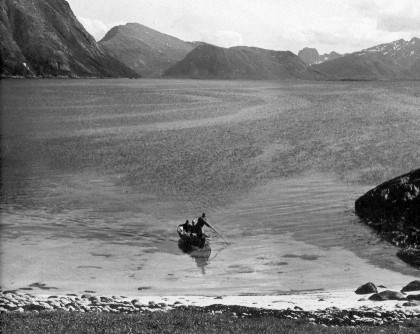 |
Skogsøya is situated almost as far north as Point Barrow in Alaska, but the climate is much warmer, because the Gulf Stream carries so much warmth to our coastal waters. Here's no ice in the winters, and no icebergs crossing the horizon. Instead you'll find an abundance of animal and plant life. And of course you can experience very fine summer days, ideal for a boat trip across a very clear sea. This picture was taken in the first days of July, and there still are some patches of snow on the mountains in the background. By the way, the boat is arriving at the low island you can see off the mainland at the top picture on this page. This is a 'eggvær', a place where we collect seagull eggs. We take two og three eggs from each nest, not more, or else the birds will leave the island, and then there will be no seagull eggs for many years. To harvest the nature without raping it is a very old way of living - or surviving - at this part of the world. At this island we also find cloudberries, very tasty and packed with Vitamin C. Such small places can tell very much about a way of living that was ecologically sound and relied on local resources. That way of living is almost gone, but we can still take a little summer trip to this island and have a beautiful day. |
I've used these pictures as windows. Through them you can look at a landscape and a history that may seem strange and perhaps interesting to you. Curious? Come and visit us, then!